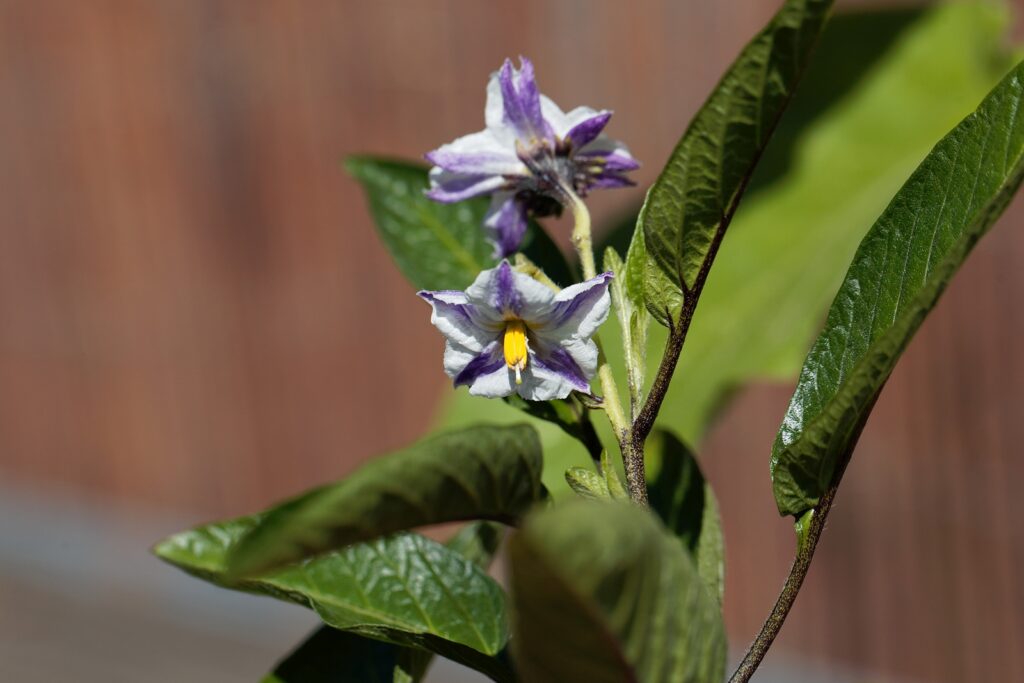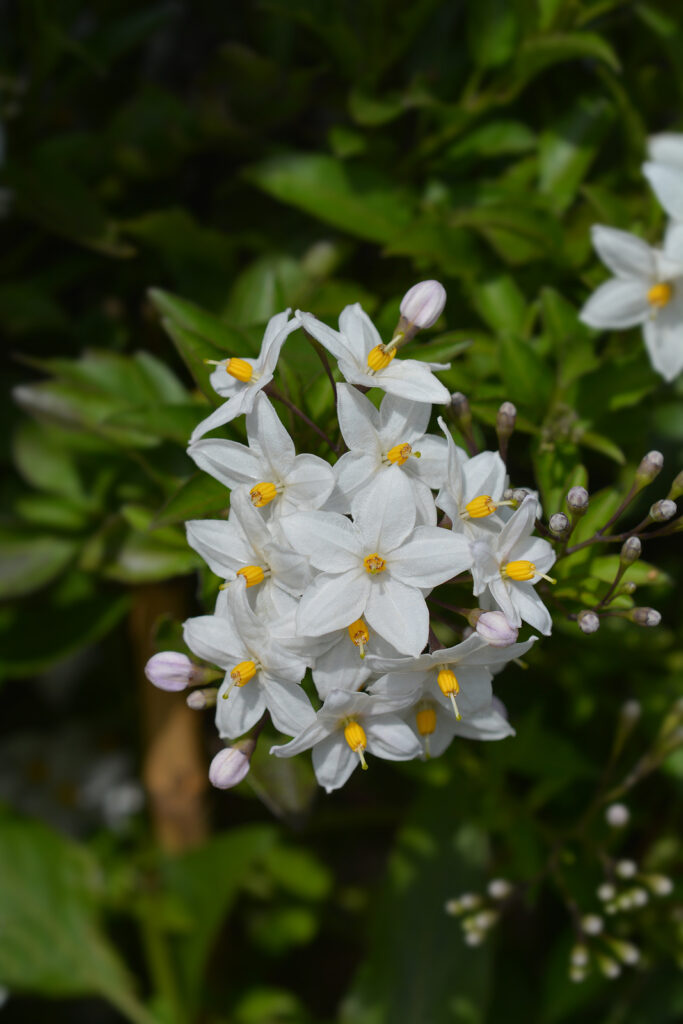Solanum vines are members of the Solanum or Nightshade family. They are trailing and often twisting vines with clusters of white, blue, or purple flowers with yellow centers. Solanum vines can cover fences, arbors, trellises, or plants. They grow best where winters are mild.
Solanum is a very large genus of about 1,400 species of annuals, biennials, perennials, shrubs, trees, and climbers. Along with a number of species grown as ornamentals, solanum contains four well-known vegetable crops—tomato, pepper, eggplant, and potato.
Solanum vines grow best in full sun and fertile soil that is moist but well-drained. They prefer a warm location sheltered from the wind. Leaves touched by frost or a prevailing wind will darken and often drop.
Solanum vines bloom heaviest in spring, but they repeat bloom through the summer when watered and fed monthly.
Solanum ornamentals and vines bear berry-like fruits after the flowers fade. The berries of vines and ornamental Solanum are poisonous if ingested.

Get to know Solanum
- Plant type: Evergreen and deciduous shrubs, vines, perennials
- Growing zones and range: Zones 9 and warmer
- Hardiness: Hardy to Zone 9; ornamental Solanum varieties will be severely damaged by frost
- Height and width: Varies with variety; vines grow to 20 feet (6m)
- Foliage: Leaves are alternate, entire, lobed, or pinnately divided
- Flowers: Clusters of small, five-lobed flowers that can be bell-, trumpet- or star-shaped and come in shades of lavender-blue, purple, lilac, or white.
- Bloom time: Spring and summer
- Fruit: Black ovoid berries followed flowers; all parts of these nightshade-family pants can be poisonous if ingested; the vegetable members off the genus are the exception.
- Uses: Train climbers on warm walls or trellises
- Common name: Potato vine is one ornamental vine
- Botanical name: Solanum
- Family name: Solanaceae
- Origin: A range of habitats from aroud the world
Where to plant Solanum
- Plant Solanum in full sun or partial shade. Full sun encouarages the best blooms.
- Plant Solanum in well-drained soil that remains evenly moist. Neutral to slightly alkaline soil pH is ideal.
When to plant Solanum
- Set Solanum in the garden in spring.
- Sow seeds indoors 6 to 10 weeks before the last spring frost date at 65° to 70°F (18-21°C). Germination takes 1 to 2 weeks. Transplant once the soil has warmed to 60°F and the weather has settled.
Planting and spacing Solanum
- Space Solanum vines 20 feet (6m) apart.
How to water and feed Solanum
- Give Solanum regular to moderate water.
- Fertilize Solanum with an all-purpose fertilier once a month during the growing season.

Solanum care
- Solanum climbers require a trellis or can be trained over shrubs. Stake plants, and tie climbers to supports as they grow.
- Solanum climbers will suffer in cold weather. To overwinter perennials species, you can take cuttings in mid- to late summer. Keep them on the dry side over winter, and grow them in a bright, cool (50°F) spot.
- Flowers are followed by fruits (berries) that are sometimes ornamental; all parts of these nightshade-family plants can be poisonous if ingested.
Growing Solanum as a houseplant
- Place Solanum in a room where the temperature is average to warm, light is direct, and humidity is average.
- The growing medium should be well-drained and allowed to dry slightly between waterings.
- Fertilize every two weeks.
- If growing Solanum pseudocapsicum, Jerusalem cherry, indoors, shake the plant when it is flowering to aid pollination and fruit set.
- Plants will not form satisfactory fruit for more than two years. The fruit is poisonous.
Solanum pests and diseases
- Aphids and thrips can attack Solanum.
- Late blight, damping off, powdery mildew can occur.
Solanum propagation
- Sow seeds indoors 6 to 10 weeks before the last spring frost date at 65° to 70°F. Germination takes 1 to 2 weeks. Transplant once the soil has warmed to 60°F and the weather has settled.
- Root semi-ripe cuttings of climbers and shrubs with bottom heat from summer to early autumn.

Solanum varieties to grow
- Solanum aviculare. Kangaroo apple. Tender perennial or warm-weathr annual; shrub grows 6 to 11 feet tall in frost-free areas; bears small clusters of 1 ½-inch-wide, bluish purple or white flowers in spring and summer; flowers are followed by ½-inch-long, oval fruits that turn from green to yellow. Grows best in Zone 10.
- S. crispum. Evergreen vine. Climbs to 12 feet tall, with leaves to 5 inches long; bears 4-inch clusters of fragrant lilac blue flowers with yellow centers; may lose leaves in hard frost. Cultivar ‘Glasnevin’ has deeper blue flowers in larger clusters.
- S. jasminoides. Potato vine. Vine. Twining habit and fast growth to 20 feet; purplish-tinged leaves, 1 ½-3 inch long; 1-inch-wide flowers in pure white or in white tinged with blue, in clusters of 8 to 12. Nearly perpetual bloom, heaviest in spring. Cut back to prevent tangling and promote vigorous new growth. Cultivars include ‘Album’ has white flowers; ‘Aurea’ has green and yellow variegated leaves. Tender perennial or warm-weather annual. Zones 8 to 10.
- S. muricatum. Pepino. Perennial. Sprawling plant to 2 feet tall; bright green, 3-inch leaves; blue flowers followed in summer by ovoid greenish-yellow fruit striped with purple; fruit weighs ¼-1 pounds., tastes like a cross between melon and cucumber.
- S. pseudocapsicum. Jerusalem cherry. Evergreen shrub grows 3 to 4 feet tall (shorter if grown as annual); deep green, smooth, shiny leaves to 4 inches long; white flowers followed in by scarlet (rarely yellow), ½-inch fruits. Several dwarf strains to 1 foot tall.
- S. rantonnetii. See Lycianthes rantonnei
- S. seaforthianum. Brazilian nightshade. Vine; evergreen in mildest winter areas; leaves to 8 inches long; clusters of violet blue, inch-wide flowers in summer, small red fruits edible only to birds.
- S. wendlandii. Costa Rican nightshade. Deciduous vine. Tall, twining vine with prickly stems; large leaves 4 to 10 inches long, lower ones divided into leaflets. Large clusters of 2 ½-inch, lilac blue flowers in summer.















